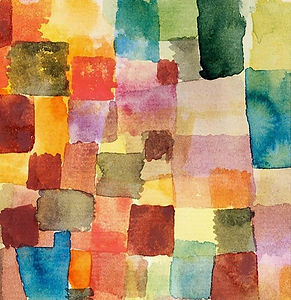

Paul Klee Gallery
Step into a world of color, form, and imagination with this curated collection of abstract art prints inspired by the timeless works of Paul Klee. These pieces blend expressive geometry, watercolor textures, and harmonious palettes to bring warmth and sophistication to any space. Ideal for design lovers, stylists, and collectors seeking art that sparks thought and elevates interiors with a quiet boldness.
Styled in real homes

Untitled (1914)
An extraordinary example of Paul Klee’s early experimentation with color and abstraction, Untitled (1914) reveals the artist’s fascination with geometry, texture, and coded markings. Rich with layered hues—deep burgundy, golden ochre, teal, and smoky plum—the composition evokes a dreamlike landscape filled with mystery. The subtle grid and fine, almost hieroglyphic lines hint at maps, cities, or musical notations, inviting the viewer into a contemplative space between chaos and order. This rare piece from the Kunstmuseum Basel Collection offers a glimpse into Klee’s transition from representational art to pure abstraction.

Burgarten (1919)
With its radiant palette and architectural motifs, Burggarten (1919) is a vibrant celebration of Paul Klee’s imaginative geometry. Translating the idea of a “castle garden” into a kaleidoscope of color and form, Klee blends arches, floral shapes, and tessellated patterns into a dreamlike, mosaic-like composition. The layered textures and contrasting tones—from dusty pinks and lavenders to rich emeralds and golds—evoke both the structure of a garden and the fantasy of a fairytale setting. This work, part of the Kunstmuseum Basel Collection, reflects Klee’s deep exploration of harmony, symmetry, and spiritual symbolism during the post-war years.

Polyphonic Architecture (1930)
In Polyphonic Architecture (1930), Paul Klee orchestrates a visual symphony of structure and sound. Overlapping translucent blocks of warm ochres, dusky blues, and muted reds create a harmonious grid that resembles a city or cathedral complex. Within this composition, finely inked architectural forms rise like musical notes, suggesting rhythm, repetition, and balance—hallmarks of Klee’s Bauhaus period. The title reflects the fusion of music and architecture, two of Klee’s lifelong inspirations, presented here as a layered, meditative abstraction. Held in the Art Museum of Saint Louis, this piece exemplifies Klee’s masterful ability to unify logic and lyricism through color and form.

Untitled (1914)
Untitled (1914) captures Paul Klee’s early mastery of color and abstraction through a mosaic of luminous watercolor squares. Each patch, whether softly blended or richly pigmented, evokes the spontaneity of emotion and the quiet rhythm of a painter deeply attuned to harmony. The palette ranges from earthy reds and golden ochres to soft purples and brilliant teals—an exploration of tonal relationships that feels both playful and poetic. Created during a formative period of Klee’s artistic evolution, this piece exemplifies his sensitivity to color theory and the influence of his travels and inner landscapes. Now held by The MET Museum, it stands as a vibrant tribute to Klee’s intuitive, dreamlike style.

Terraced garden (1920)
Terraced Garden (1920) invites viewers into a dreamlike topography built from layered blocks of deep teal, forest green, and violet. In this richly textured piece, Paul Klee evokes a fantastical landscape—a mosaic of elevated garden planes, shadowy silhouettes, and luminous highlights that hint at rooftops, foliage, and distant light. The interplay of opacity and transparency creates a visual rhythm that feels both grounded and ethereal, as if the viewer is drifting through a twilight garden suspended in time. A beautiful example of Klee’s symbolic abstraction and sensitivity to atmosphere, this work captures the quiet poetry of constructed nature and imagined memory.
Suburban idyll (garden city idyll) (1926)
In Suburban Idyll, Paul Klee presents a whimsical mosaic of pastel hues and etched lines that evoke the delicate architecture of a dreamlike townscape. Created in 1926, this work belongs to Klee’s period of experimentation with color-blocking and symbolic abstraction. Earthy pinks, soft ochres, and patches of sunflower yellow form the foundation of a gridded composition reminiscent of maps or patchwork gardens. The etched motifs — houses, trees, ladders — suggest a peaceful coexistence of nature and structure, idealizing a utopian suburban landscape. Klee’s unique visual language turns everyday forms into poetic meditations, inviting viewers to lose themselves in a nostalgic reverie.











